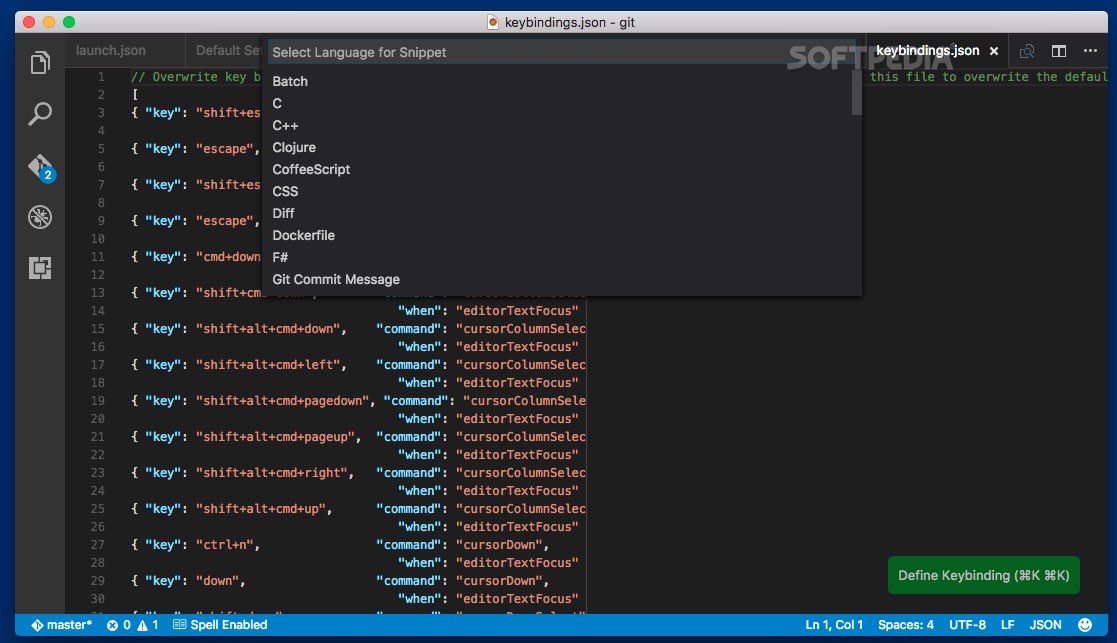
When I got my Windows computer, the first thing I did was to set up Windows so it mirrors the writing system I had on Mac. I also mirrored Mac's modifiers as much as possible.
Then, I set up my Windows development environment (with Windows Subsystem for Linux) on my new Windows computer.
Drag 'Visual Studio Code.app' to the 'Applications' folder, so as it available in the 'Launchpad.' Double click on the 'Visual Studio Code' to open. Add VS Code to your Dock by right-clicking on the icon to bring up the context menu and choosing Options = Keep in Dock. With the power of Roslyn, Visual Studio for Mac brings IntelliSense to your fingertips. IntelliSense describes APIs as you type and uses auto-completion to increase the speed and accuracy of how you write code. Quick Info tool tips let you inspect API definitions. Squiggly lines in the editor highlight issues in real time as you type.
Next, I had to do was to make Visual Studio Code on both Mac and Windows play nice.
By 'play nice', I meant:
- Syncing preferences across Mac and Windows
- Syncing extensions across Mac and Windows
- Syncing key bindings across Mac and Windows
The sims 4 minimum requirements mac. Enter Settings Sync.
Settings Sync
Settings Sync is an extension for Visual Studio Code. It lets you sync preferences and extensions. I also found out it synced key bindings later! (More on key bindings later because it's more nuanced).
It's easy to sync preferences and extensions. Settings Sync does this automatically. Download de videos. To sync extensions and preferences across my Mac and Windows computer, all I had to do is install the settings sync extension, log in with Github, and, select a Gist to sync to.
Visual Studio Code On Mac Review
Separating preferences for Windows and Mac
Thankfully, most of my preferences can be shared between Windows and Mac. I don't have to change many things. I only changed the fontSize of the code editor and the integrated terminal between my Windows and Mac.
I changed fontSize because I have a 15' Mac and a 13' Windows. Their screen resolutions were different too. After some testing, I figured I needed the following sizes:
- Mac:
18px - Mac (Integrated Terminal):
16px - Windows:
16px - Windows (Integrated Terminal):
14px
Settings Sync lets you preserve specific settings with a thing they call sync pragmas. A pragma is a piece of code that tells a compiler about something. In this case, the sync pragmas tell Settings Sync whether to keep a specific setting.
Sync pragma looks like this:
A sync pragma can only be applied to one property (as far as I can tell).
I used the Operating System pragma (os) to preserve preferences between Mac and Windows. Here's what I wrote for Mac:
And here's what I wrote for Windows:
Settings decides whether to apply a property with sync pragmas. If Settings Sync thinks the property should be disabled, it'll comment it out.
For example, anything labelled with os=windows got commented out on my Mac's preferences (the settings.json file).
Likewise anything labelled with os=mac got commented out on my Windows' settings.json file.
Download Visual Studio Code For Windows 10
So I get to keep the settings I like for both computers. Huge casino slot wins. Pretty cool!
Settings Sync is a real lifesaver here :)
Syncing keyboard shortcuts
If you can keep preferences with sync settings, how do you keep preferences for keyboard shortcuts?
I put a ton of effort into customising my keyboard shortcuts. (I'll share them in the next article). And I'm worried my shortcuts will overwrite each other.
Turns out, there's nothing to worry!
Visual Studio Code For Beginners
Settings Sync is smart. It uses a file called keyBindings.json to store Windows shortcuts. For Mac, it uses a file called keybindingsMac.json. Rar reader mac.
So feel free to upload your key bindings without adding any comments. They would NOT overwrite each other.
Other media players for mac. This, however, means you need to configure key bindings for Mac and Windows separately.
I'll share my configurations in the next article. Premiere pro cs5 mac download.
If you enjoyed this article, please tell a friend about it! Share it on Twitter. If you spot a typo, I'd appreciate if you can correct it on GitHub. Thank you!
Visual Studio Code provides developers with a new choice of developer tool that combines the simplicity and streamlined experience of a code editor with the best of what developers need for their core code-edit-debug cycle. Visual Studio Code is the first code editor, and first cross-platform development tool – supporting macOS, Linux, and Windows – in the Visual Studio family.
At its heart, Visual Studio Code features a powerful, fast code editor great for day-to-day use. The Preview release of Code already has many of the features developers need in a code and text editor, including navigation, keyboard support with customizable bindings, syntax highlighting, bracket matching, auto indentation, and snippets, with support for dozens of languages.
For serious coding, developers often need to work with code as more than just text. Visual Studio Code includes built-in support for always-on IntelliSense code completion, richer semantic code understanding and navigation, and code refactoring. In the Preview, Code includes enriched built-in support for ASP.NET 5 development with C#, and Node.js development with TypeScript and jаvascript, powered by the same underlying technologies that drive Visual Studio. Code includes great tooling for web technologies such as HTML, CSS, LESS, SASS, and JSON. https://cwtu.over-blog.com/2021/01/quartzcode-1-39-10-download-free.html. Code also integrates with package managers and repositories, and builds and other common tasks to make everyday workflows faster. And Code understands Git, and delivers great Git workflows and source diffs integrated with the editor.
